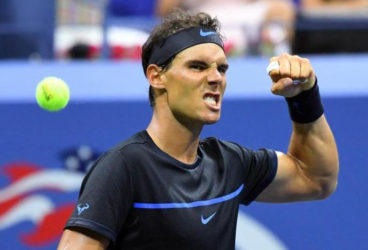NEW YORK, (Reuters) – In 2010, Rafa Nadal tweaked his service action to give him more power and it helped him to U.S. Open glory later that year.
Six years on and despite the effects of a wrist injury, it looks as though he may have found another secret weapon as he bids to win a third U.S. Open crown.
While in 2010 it was an adjustment to his grip that enabled him to hit 130mph serves, this time the Spaniard has shifted his serving position on the ad-court, standing far wider than usual.
“We had to change something,” Toni Nadal, the 14-times grand slam champion’s coach and uncle, told Reuters. “We needed to make something different with the serve (so) we open a little more for doing the slice and angle.”
When serving in the ad-court – the side where the majority of key points are played – Nadal is now standing about halfway across to the tramlines, rather than in the more traditional position next to the centre line.
That gives him a bigger angle to hit to the right-hander’s backhand, increasing his chances of starting the point with his favoured forehand.
Crucially, because he is standing further to the left, this means the Spaniard can better protect himself against the flat backhand crosscourt return, which Novak Djokovic and Andy Murray have used to such devastating effect against him.
“Yes, yes (that is true) a little, but at the moment it’s not against Djokovic or Murray,” ToniNadal said. “It’s against his next opponent.
Nadal introduced the serving position change in Barcelona this April but his lingering wrist injury meant he was unable to use it at the French Open, or at Wimbledon.
HUGELY EFFECTIVE

Craig O’Shannessy, a strategy expert for Wimbledon, the Australian Open, New York Times and the ATP Tour who runs a strategy website called braingametennis.com, said the switch was already proving hugely effective.
“It stops the crosscourt return,” he told Reuters. “I don’t mind saying it was in the game plan when I was with Dustin (Brown) at Wimbledon (when he beat Nadal in 2015) to do it and to do it early.
“That’s a really big benefit (for Nadal). He’s also still able to run around everything … the percentages are so much better for him.”
O’Shannessy examined data from Nadal’s opening two matches, against Denis Istomin and Andreas Seppi, and found that the Spaniard was also showing more variety.
“On first serve, against Seppi, he actually served more into the body and forehand than out wide to the backhand,” he said. “Against Istomin, it was the opposite. It’s almost a bit of a bluff and it’s working.”
Standing so far to the left and then serving out wide leaves a bigger-than-usual gap for the returner to hit down the line.
But Nick Bollettieri, the famed coach who helped players such as Andre Agassi and Monica Seles become world number one, said that finding that spot was far from easy.
“He’s changed his serving position to where (John) McEnroe used to be, which leaves the whole court open,” Bollettieri told Reuters.
“But remember, if the slice serve takes you 10 feet out of court, you have got to be pretty damned good to hit the ball down the line.”
Former world number one Mats Wilander, who is working at the U.S. Open for Eurosport, was not sold on how effective Nadal’s service strategy would be against the very best players.
“You find your range on the return at some point,” Swede Wilander told Reuters. “It’s difficult in the beginning but over five sets, you’ll find the down-the-line (return) and the height you need to get back to the middle.
“So I think it’s maybe just searching for something slightly different.”





